Preprint
Article
Sustainable Energy Innovation: Patent Analysis and Assessment for NiMH Battery Regeneration
Altmetrics
Downloads
116
Views
59
Comments
0
A peer-reviewed article of this preprint also exists.
Submitted:
05 July 2024
Posted:
08 July 2024
You are already at the latest version
Alerts
Abstract
In the ongoing shift towards electric vehicles (EVs) primarily utilizing lithium-ion battery technology, a significant population of hybrid electric vehicles (HEVs) remains operational, reliant on established NiMH battery systems. Over the last twenty years, these HEVs have generated a substantial quantity of NiMH batteries that are either inoperable, experiencing performance degradation, or approaching the end of their service life. This results in a twofold challenge: a growing volume of environmentally hazardous waste due to the difficulty of NiMH battery reclamation, and escalating maintenance costs for HEV owners necessitated by replacement battery purchases. Patent WO2015092107A1, published in 2015, proposed a "Method for regenerating NiMh batteries." This method claims the ability to restore NiMH batteries to their original functionality. However, a comprehensive review of relevant scientific literature fails to identify any empirical evidence supporting the efficacy of the regeneration technique detailed in the patent. Within this context, this paper presents a detailed analysis and evaluation of the feasibility of the aforementioned patented method. To achieve this objective, the authors propose a prototype constructed utilizing NiMH battery cells sourced from a Toyota Prius. The experimental results obtained from this prototype demonstrate the potential for battery regeneration using the proposed method. These findings offer a promising solution for mitigating the challenges associated with NiMH battery disposal and maintenance within the HEV domain.
Keywords:
Subject: Engineering - Electrical and Electronic Engineering
1. Introduction
During the last years, several authors have analyzed the developments and future of electric mobility [1,2,3]. The International Energy Agency (IEA), in the global electric vehicle (EV) outlook 2022 report, analyzed recent developments in electric mobility including an analysis of the supply chain of batteries for electric vehicles. The results indicated that sales of electric vehicles were growing at an exponential rate such as in 2021; when they doubled compared to the previous year; being the main drawback for the sales of electric vehicles the price of materials for the manufacture of batteries. In [4], it is pointed out that around 230 million EVs will circulate in 2030, whose battery needs can be reduced through reuse, recycling, circular economy, and improvements in technology. It was identified a decrease in the price of batteries by 2050 in [5], but the obstacle of increasing the price of materials due to their scarcity still exists, as was affirmed in [6]. With this scenario of growth in EV sales and the depletion of materials for the manufacture of battery cells, it can be identified the following problems: (i) the large number of batteries to be discarded at the end of their useful life, a number that probably will be growing exponentially as well as the sale of vehicles, (ii) a relevant waste problem due to difficulties to recycle and reuse. Preeti and Sayali [7] conducted some considerations regarding the problem of EV recycling batteries. According to the specific literature, 113 publications focused on the recycling of these batteries can be identified. (iii) a problem due to the lack of materials for the manufacture of batteries.
It can be found initiatives to extend the useful life of batteries, by using them for lower demanding services than in vehicles. For example, for the storage of renewable energies, where batteries that have lost part of their health are still used for this type of storage, not the system being affected by being a stationary system and not having large space requirements, or to supply during peak periods of distribution power systems [8]. Other studies describe the feasibility of giving a second use to lithium batteries from electric vehicles in communications bases, concluding that the use of batteries in second life reduces processing loads and environmental impact. In [9], it was analyzed how the EV batteries at the end of their life can serve as emergency storage in high population places, providing additional grid storage options to the grid under possible disasters. In this way, [10] estimated a 56% reduction in CO2 emissions compared to supplying that need with natural gas. In [11], it is concluded through a cascade life cycle analysis (LCA) the potential decreasing in five main indicators: Global warming potential, photochemical oxidation formation potential (POFP), particulate matter formation potential (PMFP), freshwater eutrophication potential (FEP), and fossil-resource depletion potential (FDP)based on the use of EV vehicle batteries in stationary applications after the end of the useful life of these batteries in vehicles. In [12], and through a life cycle analysis, it was established that the reduction of greenhouse gases (GHG) in different types of lithium batteries varied between 2.76 and 4.55 kg CO2/kg of battery depending on the technology used for recycling, comparing recycled batteries to the production of new ones. Other contributions, such as [13], analyzed the situation in China, comparing the recycling of electric vehicles through an LCA, concluding that, if they were recycled at the end of their life, a GHG saving of 34% could be achieved in comparison to their production processes. Indeed, notwithstanding the potential extension of battery lifespan, eventual disposal becomes inevitable, categorizing them as waste materials.
There are numerous contributions describing solutions to give batteries a second life, such as [14,15,16] [17,18]. They concluded that reusing the battery is a remarkable option as it would delay the need for battery recycling. Moreover, it would also allow battery recycling companies to develop cost and energy efficient processes. In [19], it is noted that the industry is currently not prepared for mass dismantling of batteries that can generate recycling and a true circular economy. Therefore, it is necessary to modify the design of batteries by including dismantling and recycling in this criterion. In most of the proposed solutions, the authors assert the imperative of extending the operational longevity of batteries, thereby mitigating both economic and environmental ramifications. However, it is inevitable that they will ultimately deplete and transition into waste material necessitating recycling measures. Technologies for recycling lead acid type batteries are well known [20]. However, there is a lack of contributions focused on battery technologies for hybrid and electric vehicles. Recent contributions can be found in [21,22,23] [24], mainly evaluating waste treatment processes. Subsequently, exploring alternative solutions such as battery regeneration becomes imperative. Rather than disposing of batteries at the end of their lifespan, regeneration offers the prospect of transforming them back into functional products. Moreover, this approach mitigates the issue of soaring raw material costs by obviating the need for fresh materials in manufacturing.
Battery regeneration is known and used for a long time in lead acid battery technologies [25]. However, there are minor contributions for battery regeneration purposes applied to other technologies. In [26], four methods for regenerating NiMH batteries are delineated. One method necessitates disassembling the battery structure to access the materials for regeneration. Another method lacks sufficient data for replication. A third method involves a charging technique that extends battery lifespan more effectively than regeneration. The fourth method, outlined in patent WO2015092107A1 [27], proposes regenerating batteries comprising multiple cells according to a specified cycle detailed in the patent. After the patent's publication, no further scientific literature has emerged either substantiating or refuting its efficacy. Table 1 summarizes these contributions. Additionally, there a lack of technical services specializing in battery regeneration based on this patent's method or any other alternative approach. Under this framework, this paper aims to assess in a practical and suitable manner the regeneration process of NiMH batteries based on the method outlined in the previous patent. This evaluation is conducted through a prototype developed by the authors and through real-test experiment involving the practical application of the method to a deteriorated Toyota Prius battery. The results provide valuable insights into its feasibility. The objectives of this work thus include a prototype proposed by the authors to verify the described patent performance in terms of battery regeneration purposes, which can be extended and used in other battery regeneration solutions based on charging-discharging controlled cycles.
The rest of the paper is structured as follows. Technical characteristics, electrical diagrams and components are described in detail in Section 2. In addition, the proposed method to evaluate the patent performance can be also found in Section 2. Results for this case study are provided in Section 3 and discussed in Section 4. Finally, conclusions are given in Section 5.
2. Materials and Methods
2.1. General Description
Regarding the patent WO2015092107A1, it is described in detail that, for the regeneration of a battery cell, it is necessary to carry out a series of controlled discharges and charges of the battery at constant current. With this aim, a standard battery charger or a battery regenerator should be used. These solutions are commonly used for the regeneration of properly configured lead batteries. As can be found in the patent, a Toyota Prius battery is preferably used, which included 28 NiMH cells with a nominal voltage of 7.2 V and a capacity of 6.5 Ah. According to these controlled charging-discharging requirements, a prototype is proposed and implemented by the authors. It is capable of charging and discharging in a controlled manner at a constant intensity the group of 28 cells in a simultaneously manner. The general operation scheme of the proposed methodology can be found in Figure 1. Based on this operation scheme, Table 2 summarizes the main characteristics and ranges of the expected prototype. Indeed, and under the development phase of any process or system, it is crucial to create a prototype to assess its functionality and behavior. Even with a comprehensive plan or schematic such as Figure 1 depicted, prototyping allows for practical validation and identification of potential issues that may not have been apparent during the planning stage. By building a prototype, engineers and designers can test the feasibility of their ideas, identify design flaws or inefficiencies, and gather valuable feedback from stakeholders and end users. This iterative process of prototyping and testing enables refinement and optimization, ultimately leading to the development of a more robust and effective final product or process.
By considering the operational scheme showed in Figure 1, and according to the specific characteristics for the prototype summarized in Table 2, a general operation of the prototype for both charging and discharging processes can be found in the Figure 2. Proposing electrical circuit diagrams based on the previous process diagrams depicted in Figure 2 is essential for ensuring the successful implementation and operation of processes.
Moreover, it enables comprehensive planning, precise equipment selection, and effective integration of electrical systems into the overall process design. Additionally, clear, and detailed electrical diagrams facilitate troubleshooting, maintenance, and future modifications, contributing to the overall efficiency and reliability of the industrial system.
2.2. Prototype Description And Implementation
From the previous operational schemes, Figure 3 and Figure 4 show the proposed electrical diagram for the charging and discharging processes to be implemented in the prototype. Subsequently, and from these electrical diagrams, the prototype was implemented by the authors by considering the following components according to the number of cells to be regenerated. In this case, 28 adjustable current voltage power supplies were proposed and implemented, see Figure 5, by means of which the constant charge current at which each cell is to be charged is selected. Each of these power sources are connected to one of the battery cells, charging independently and providing an independent process for each cell, as the patent suggested. In addition, 28 potentiometers were selected as well, see Figure 6, on which each of the cells are discharged to vary their resistance values as the cell voltage decreases, remaining constant the discharge current. In this preliminary evaluation process, the variation of the potentiometer resistance is carried out manually based on the values given by the display on the process.
Figure 7 shows the monitoring system selected to track the voltage, current, and power flow—both charging and discharging processes—of individual cells within the regeneration battery process. This display enables a comprehensive assessment of each cell's performance, allowing for an accurate analysis and comparison throughout the regeneration process of the 28 displays that monitor the previous parameters of each cell. To streamline the process and eliminate the need for manually connecting and disconnecting each battery cell to various power supplies and potentiometers across multiple cycles, electrical circuits incorporating relays have been devised. As depicted in Figure 8, these circuits facilitate seamless switching between two previous modes: charging and discharging processes. A single switch toggles all cells simultaneously between the charging circuit—connecting power supplies to cells—and the discharging circuit—linking cells to potentiometers.
Consequently, only the battery cells need to be connected to the prototype via their cell terminals, while all power sources are connected to the prototype through designated terminals. With the assistance of this switch, the entire battery can transition between charge and discharge modes in unison, enabling simultaneous regeneration of all battery cells. Additionally, the prototype includes an individual switch for each of the battery cells, 28 switches in total. These switches serve to isolate each cell, maintaining them in an open circuit state, thereby disconnecting them from the charging or discharging processes. This functionality is crucial as the charging or discharging times may vary depending on the health status of each cell. Figure 9 shows an example of switch. Consequently, as each cell completes its independent cycle, it must be taken offline to await the completion of the processes by the remaining cells. Furthermore, each circuit is equipped with protection in the form of a fuse. Specifically, the discharge circuit is safeguarded by a 1 A fuse, while the charging circuit is protected by a 1.5 A fuse.
An auxiliary power source has been integrated to supply power to the displays and relays, ensuring their seamless operation. To enhance user-friendliness and streamline operation, the components responsible for displaying data, as well as those facilitating battery and power source connections, potentiometer adjustment, and switch operation, have been consolidated onto a dedicated panel, see Figure 10 and Figure 12 accordingly. This arrangement facilitates easier access and manipulation during usage. Additionally, to optimize organization and functionality, the panel housing the relays responsible for circuit operation has been segregated onto a separate panel. This separation ensures clarity and efficiency in the management of the regeneration process.
The methodology employed involves initial preparation of the battery, entailing the disassembly of all protective components until access to the terminals of each individual cell is achieved. Subsequently, the battery is connected to the prototype detailed in this article using terminals equipped with crocodile clips at the battery end and banana plugs at the prototype end. Following this setup, a series of sequential charging and discharging cycles are executed in accordance with the method described in the patent.
3. Case Study
To assess the functionality outlined in the patent, the initial step involves selecting the cells for experimentation. To accomplish this, two Toyota Prius batteries comprising a collective total of 56 cells were utilized, and the health status of each cell was meticulously evaluated. Various methods exist for evaluating cell health, as documented in [32,33,34] [35]. In this instance, the approach outlined in [36] was adopted, wherein the State of Charge (SOC) is defined as the percentage of remaining capacity relative to the maximum available capacity of the battery [37]. This parameter can be expressed as:
where Cr represents the residual capacity available for powering electric devices, while Cm denotes the maximum storage capacity of the cell, determined by its electrochemical characteristics. For the cells under consideration in this study, as per manufacturer specifications, each cell has a capacity of Cm = 46.42 Wh. To ascertain Cr, a series of charging cycles were conducted on each cell, reaching various charge levels, followed by discharging cycles to evaluate the amount of Wh discharged.
SOC(t) = Cr/Cm X 100%,
In the aforementioned literature, various methodologies are established for determining the State of Charge (SOC) of battery cells, as evidenced in publications such as [38,39]. However, in this specific investigation, charging and discharging procedures were conducted without adherence to any methods outlined in scientific literature, in order to replicate the conditions stipulated in the patent. Initially, each cell was individually charged at a rate of 0.5 A until reaching a voltage of 8V, considering the nominal voltage of the cells to be 7.2 V. Subsequently, each cell was discharged at a rate of 0.5 A until reaching a minimum voltage of 2V. It was observed that the discharge of any cell did not exceed 9 Wh in any instance, indicating a maximum State of Health (SOH) of 19.39%. Subsequently, a series of charging cycles were conducted with the same intensity as before, while controlling the amount of energy charged. Following this, the cells were discharged, with the energy discharged measured to determine the Cc/Cm ratio, where Cc represents the charged energy. Concurrently, the SOH of each cell was calculated. The findings revealed that increasing the charged energy, up to 15 Wh, did not proportionally increase the amount of energy discharged, with some cells discharging up to 10.64 Wh, equivalent to a maximum SOH of 22.92% and a mean SOH of 18.22%. Based on the assessment of the SOH of the battery, it can be inferred that all cells are in a similar state, and notably, below the 20% SOH threshold, indicative of the end of the battery life, as can be found in [40].
Following the assessment of battery condition, 21 cells were identified and selected based on their highest State of Health (SOH) or those deemed to be in suitable operational condition. It is noteworthy that some cells exhibited sulfated terminals yet were deemed viable for operation after following the instructions outlined in patent [27]. Subsequently, each of the selected cells underwent a charging process at a constant rate of 0.5 A, followed by a discharge phase conducted in two stages. Initially, a rapid discharge was executed at 6.5 A until reaching a voltage of 5.4 V. This was succeeded by a continuous discharge at a rate of 0.6 A until reaching a cut-off voltage of 2.4 V. Throughout this procedure, both the energy charged and discharged were meticulously measured to ascertain the relationship between the two and to determine the SOH of each cell.
According to the patent, the regeneration process outlined entails an anticipated enhancement in both charge and discharge capacity, as well as an improvement in the SOH of the cell. Nevertheless, to ascertain the efficacy of the regeneration process, it has been iteratively repeated up to 9 times. Between each repetition, a predetermined cooling period, as stipulated in the patent, has been adhered to. This cooling interval ensures that the cells attain a sufficient temperature equilibrium, thereby preventing premature degradation and ensuring the integrity of the data collected. The rationale behind this iterative approach is to detect any trends indicative of improving cell characteristics, thereby gauging the success of the regeneration process, even if complete regeneration is not achieved in the initial cycle.
4. Results
The outcomes of the regeneration process are depicted in the subsequent graphs. Figure 12 illustrates the energy discharged from one of the cells following nine iterations of the regeneration procedure. While a discernible trend towards enhanced discharge capacity appears evident with each successive regeneration, it is notable that the cell's discharge values persist at markedly low levels. In Figure 13, a comprehensive view of the regeneration process is provided, depicting the discharge energy for all cells subjected to the regeneration procedure concurrently. The graph allows for a comparative analysis across multiple cells, offering insights into the collective efficacy of the regeneration process. While similar trends of marginal improvement in discharge capacity can be observed across the cells over successive regeneration cycles, it is evident that the overall discharge values remain persistently low. This collective observation underscores the challenge in achieving substantial enhancements in cell performance through the regeneration process, despite repeated iterations. Figure 14 presents the progression of the relationship between discharged energy and charged energy throughout each regeneration process for individual cells. It provides a comprehensive overview of how the discharged energy compares to the energy charged during each iteration of the regeneration process. Notably, in instances where the regeneration process has been executed, a noteworthy trend towards unity is anticipated, signifying a consistent ratio between discharged and charged energy. The convergence towards a value close to unity suggests a potential stabilization or normalization of the energy balance within the cells following the regeneration process. This trend underscores the objective of achieving equilibrium between the energy input during charging and the energy output during discharge, indicative of an optimized cell performance.
Figure 15 shows the dynamic evolution of the SOH across successive regeneration processes for individual cells. It provides a detailed examination of how the SOH of each cell evolves throughout the regeneration procedure. In cases where the regeneration process has been effective, a conspicuous trend towards a value approaching 100% is anticipated. This trajectory would signify a significant improvement in the health and functionality of the cells, approaching their optimal state. Conversely, a lack of discernible improvement or a trend towards values significantly below 100% would suggest limited efficacy of the regeneration process in restoring the cells to their optimal health. By monitoring the SOH over multiple cycles, valuable insights into the effectiveness and sustainability of the regeneration process can be gleaned, informing future strategies for battery maintenance and regeneration purposes.
As a general result, the analysis affirms that the regeneration process has not yielded significant effects, as evidenced by the failure to achieve SOH values surpassing 23% across all cells. Additionally, a lack of discernible trends is observed in most cells, suggesting that further iterations of the regeneration process may not yield substantial improvements in SOH. While a discernible trend is observable in a select few cells, its clarity is limited, and the overall efficacy of the regeneration process remains uncertain. Consequently, the data indicates that the current regeneration methodology may not be sufficiently robust in restoring cells to optimal health levels. These findings underscore the need for reassessment and refinement of the regeneration approach to enhance its effectiveness and achieve meaningful improvements in cell performance. Additionally, further investigation into alternative regeneration techniques or supplementary interventions may be warranted to address the observed limitations and optimize the rejuvenation of battery cells.
Figure 16, Figure 17, and Figure 18 provide a detailed evaluation of the SOH evolution for cells that have exhibited comparatively higher SOH values within the overall Case Study cohort. These figures offer insights into the progression of SOH across multiple regeneration cycles for select cells that have demonstrated superior performance relative to their counterparts. Notably, a notable improvement in SOH is observed with each successive regeneration cycle, with enhancements ranging between 47% and 58%. This observed trend underscores the potential for substantial improvements in cell health through iterative regeneration processes, particularly in cells exhibiting initially higher SOH values. The consistent upward trajectory in SOH values across multiple cycles suggests a promising avenue for achieving significant enhancements in cell performance and longevity. However, further analysis is warranted to discern the underlying factors contributing to the observed improvements and to assess the sustainability of these gains over extended periods of operation. These findings underscore the importance of ongoing monitoring and optimization of regeneration processes to maximize the efficacy of battery maintenance strategies.
5. Discussion
To further advance this study, it would be imperative to conduct similar tests using battery cells exhibiting a diverse range of SOH levels. Existing literature, such as [41], suggests that vehicle batteries are commonly replaced when their SOH falls below 80%, with [42] proposing a replacement threshold within the 70-80% SOH range. Unfortunately, obtaining batteries with sufficiently high SOH levels for verification purposes has proven challenging. The absence of suitable batteries precludes the examination of regeneration efficacy at SOH levels of 70% or higher. Consequently, while this study concludes that the patent may not be applicable to cells beyond their useful lifespan or those with severely diminished health, it remains inconclusive regarding the potential regeneration of cells with higher SOH values. A comprehensive follow-up study should involve a sizable sample of cells categorized based on their SOH levels, spanning from 30% to 80% at 10% intervals, to ascertain the feasibility of regeneration across varying health states. Such verification would necessitate the utilization of an advanced prototype model capable of automation, particularly in streamlining processes such as automatic readjustment of charging and discharging intensities. The current manual process is notably slow and requires constant human oversight, making automation crucial for expediting experimentation and data collection. An ideal prototype for this purpose could leverage advancements outlined in [43], which presents a battery characterization system incorporating IoT technology and low-cost hardware. Implementation of such a prototype would enhance efficiency, reliability, and scalability, thereby facilitating rigorous and comprehensive experimentation to elucidate the potential and limitations of cell regeneration across a broad spectrum of SOH levels.
6. Conclusions
This study aimed to assess the effectiveness of a patented method for regenerating NIMH cells. This evaluation is conducted through a prototype developed by the authors and through real-test experiment involving the practical application of the method to a deteriorated Toyota Prius battery. Following the proposed steps outlined in the patent, the initial diagnosis of the cells was conducted to determine their State of Health (SOH). Subsequently, the complete regeneration process was applied to 21 selected cells. However, contrary to the expectations outlined in the patent, none of the cells showed signs of regeneration after the first application of the process. In response to this unexpected outcome, the process was repeated nine consecutive times, adhering to the specified time intervals indicated in the patent. Despite these repeated attempts, none of the cells demonstrated any regeneration. In conclusion, our findings suggest that the regeneration process described in the patent is ineffective for cells with very low SOH or those nearing the end of their lifespan. Further research and development efforts may be necessary to refine the regeneration process and improve its efficacy in such cases.
Author Contributions
Conceptualization, R.M.S, A.M.G and A.P.R.G; methodology, R.M.S and A.M.A., formal analysis, R.M.S and A.P.R.G; resources, R.M.S and A.M.A., writing original draft preparation, R.M.S, writing review and editing, R.M.S and A.M.A.; supervision, A.M.G. All authors have read and agreed to the published version of the manuscript.
Data Availability Statement
The data that support the findings of this study are available from the corresponding author, upon reasonable request.
Conflicts of Interest
The authors declare no conflicts of interest.
References
- Kumar RR, Alok K. Adoption of electric vehicle: A literature review and prospects for sustainability. J Clean Prod 2020;253:119911. [CrossRef]
- Mounce R, Nelson JD. On the potential for one-way electric vehicle car-sharing in future mobility systems. Transp Res Part A Policy Pract 2019;120:17–30. [CrossRef]
- Chian TY, Wei WLJ, Ze ELM, Ren LZ, Ping YE, Abu Bakar NZ, et al. A Review on Recent Progress of Batteries for Electric Vehicles. International Journal of Applied Engineering Research 2019;14:4441–61.
- Nurdiawati A, Agrawal TK. Creating a circular EV battery value chain: End-of-life strategies and future perspective. Resour Conserv Recycl 2022;185:106484. [CrossRef]
- Mauler L, Duffner F, Zeier WG, Leker J. Battery cost forecasting: a review of methods and results with an outlook to 2050. Energy Environ Sci 2021;14:4712–39. [CrossRef]
- Turcheniuk K, Bondarev D, Amatucci GG, Yushin G. Battery materials for low-cost electric transportation. Materials Today 2021;42:57–72. [CrossRef]
- Preeti M, Sayali A. Scientometric Analysis of Research on End-oflife Electronic Waste and Electric Vehicle Battery Waste. Journal of Scientometric Research 2021;10:37–46. [CrossRef]
- Yang J, Gu F, Guo J. Environmental feasibility of secondary use of electric vehicle lithium-ion batteries in communication base stations. Resour Conserv Recycl 2020;156:104713. [CrossRef]
- Moore EA, Russell JD, Babbitt CW, Tomaszewski B, Clark SS. Spatial modeling of a second-use strategy for electric vehicle batteries to improve disaster resilience and circular economy. Resour Conserv Recycl 2020;160:104889. [CrossRef]
- Ahmadi L, Yip A, Fowler M, Young SB, Fraser RA. Environmental feasibility of re-use of electric vehicle batteries. Sustainable Energy Technologies and Assessments 2014;6:64–74. [CrossRef]
- Ahmadi L, Young SB, Fowler M, Fraser RA, Achachlouei MA. A cascaded life cycle: reuse of electric vehicle lithium-ion battery packs in energy storage systems. Int J Life Cycle Assess 2017;22:111–24. [CrossRef]
- Rosenberg S, Kurz L, Huster S, Wehrstein S, Kiemel S, Schultmann F, et al. Combining dynamic material flow analysis and life cycle assessment to evaluate environmental benefits of recycling – A case study for direct and hydrometallurgical closed-loop recycling of electric vehicle battery systems. Resour Conserv Recycl 2023;198:107145. [CrossRef]
- Hao H, Qiao Q, Liu Z, Zhao F. Impact of recycling on energy consumption and greenhouse gas emissions from electric vehicle production: The China 2025 case. Resour Conserv Recycl 2017;122:114–25. [CrossRef]
- Hossain E, Murtaugh D, Mody J, Faruque HMR, Haque Sunny MdS, Mohammad N. A Comprehensive Review on Second-Life Batteries: Current State, Manufacturing Considerations, Applications, Impacts, Barriers & Potential Solutions, Business Strategies, and Policies. IEEE Access 2019;7:73215–52. [CrossRef]
- Zhao Y, Pohl O, Bhatt AI, Collis GE, Mahon PJ, Rüther T, et al. A Review on Battery Market Trends, Second-Life Reuse, and Recycling. Sustainable Chemistry 2021;2:167–205. [CrossRef]
- Deng Y, Zhang Y, Luo F, Mu Y. Operational Planning of Centralized Charging Stations Utilizing Second-Life Battery Energy Storage Systems. IEEE Trans Sustain Energy 2021;12:387–99. [CrossRef]
- Shahjalal M, Roy PK, Shams T, Fly A, Chowdhury JI, Ahmed MdR, et al. A review on second-life of Li-ion batteries: prospects, challenges, and issues. Energy 2022;241:122881. [CrossRef]
- Kotak Y, Marchante Fernández C, Canals Casals L, Kotak BS, Koch D, Geisbauer C, et al. End of Electric Vehicle Batteries: Reuse vs. Recycle. Energies (Basel) 2021;14:2217. [CrossRef]
- Glöser-Chahoud S, Huster S, Rosenberg S, Baazouzi S, Kiemel S, Singh S, et al. Industrial disassembling as a key enabler of circular economy solutions for obsolete electric vehicle battery systems. Resour Conserv Recycl 2021;174:105735. [CrossRef]
- Li M, Yang J, Liang S, Hou H, Hu J, Liu B, et al. Review on clean recovery of discarded/spent lead-acid battery and trends of recycled products. J Power Sources 2019;436:226853. [CrossRef]
- Yu Y, Chen B, Huang K, Wang X, Wang D. Environmental Impact Assessment and End-of-Life Treatment Policy Analysis for Li-Ion Batteries and Ni-MH Batteries. Int J Environ Res Public Health 2014;11:3185–98. [CrossRef]
- Pindar S, Dhawan N. Recycling of mixed discarded lithium-ion batteries via microwave processing route. Sustainable Materials and Technologies 2020;25:e00157. [CrossRef]
- Xianlai Zeng, Jinhui Li, Yusen Ren. Prediction of various discarded lithium batteries in China. 2012 IEEE International Symposium on Sustainable Systems and Technology (ISSST), IEEE; 2012, p. 1–4. [CrossRef]
- Jo C-H, Myung S-T. Efficient recycling of valuable resources from discarded lithium-ion batteries. J Power Sources 2019;426:259–65. [CrossRef]
- Sun RL, Hu PQ, Wang R, Qi LY. A new method for charging and repairing Lead-acid batteries. IOP Conf Ser Earth Environ Sci 2020;461:12031. [CrossRef]
- Martínez-Sánchez R, Molina-García A, Ramallo-González AP. Regeneration of Hybrid and Electric Vehicle Batteries: State-of-the-Art Review, Current Challenges, and Future Perspectives. Batteries 2024;10:101. [CrossRef]
- Rodrigo GOMEZ PEREZ R, OMAÑA MARTIN A. Método para regenerar baterías de Ni-MH, 2014.
- Zhang J, Yu J, Cha C, Yang H. The effects of pulse charging on inner pressure and cycling characteristics of sealed Ni/MH batteries. J Power Sources 2004;136:180–5. [CrossRef]
- Li Li, Wu Feng, Chen Renjie, Gao Xueping, Shan Zhongqiang. A new regeneration process for spent nickel/metal hydride batteries. Transaction of Noferrous Metal Society of China 2005;4:764–8.
- Salkind AJ, Fennie C, Singh P, Atwater T, Reisner DE. Determination of state-of-charge and state-of-health of batteries by fuzzy logic methodology. J Power Sources 1999;80:293–300. [CrossRef]
- Prada E, Bernard J, Sauvant-Moynot V. Ni-MH battery ageing: from comprehensive study to electrochemical modelling for state-of charge and state-of-health estimation. IFAC Proceedings Volumes 2009;42:123–31. [CrossRef]
- Blanke H, Bohlen O, Buller S, De Doncker RW, Fricke B, Hammouche A, et al. Impedance measurements on lead–acid batteries for state-of-charge, state-of-health and cranking capability prognosis in electric and hybrid electric vehicles. J Power Sources 2005;144:418–25. [CrossRef]
- Li W, Rentemeister M, Badeda J, Jöst D, Schulte D, Sauer DU. Digital twin for battery systems: Cloud battery management system with online state-of-charge and state-of-health estimation. J Energy Storage 2020;30:101557. [CrossRef]
- Kim J, Yu J, Kim M, Kim K, Han S. Estimation of Li-ion Battery State of Health based on Multilayer Perceptron: as an EV Application. IFAC-PapersOnLine 2018;51:392–7. [CrossRef]
- Galeotti M, Giammanco C, Cinà L, Cordiner S, Di Carlo A. Synthetic methods for the evaluation of the State of Health (SOH) of nickel-metal hydride (NiMH) batteries. Energy Convers Manag 2015;92:1–9. [CrossRef]
- Wang Z, Feng G, Zhen D, Gu F, Ball A. A review on online state of charge and state of health estimation for lithium-ion batteries in electric vehicles. Energy Reports 2021;7:5141–61. [CrossRef]
- Il-Song Kim. Nonlinear State of Charge Estimator for Hybrid Electric Vehicle Battery. IEEE Trans Power Electron 2008;23:2027–34. [CrossRef]
- Wu Guoliang, Lu Rengui, Zhu Chunbo, Chan CC. State of charge Estimation for NiMH Battery based on electromotive force method. 2008 IEEE Vehicle Power and Propulsion Conference, Harbin, Hei Longjiang, China: IEEE; 2008, p. 1–5. [CrossRef]
- Bundy K, Karlsson M, Lindbergh G, Lundqvist A. An electrochemical impedance spectroscopy method for prediction of the state of charge of a nickel-metal hydride battery at open circuit and during discharge. J Power Sources 1998;72:118–25. [CrossRef]
- Hu X, Feng F, Liu K, Zhang L, Xie J, Liu B. State estimation for advanced battery management: Key challenges and future trends. Renewable and Sustainable Energy Reviews 2019;114:109334. [CrossRef]
- Zhu J, Mathews I, Ren D, Li W, Cogswell D, Xing B, et al. End-of-life or second-life options for retired electric vehicle batteries. Cell Rep Phys Sci 2021;2:100537. [CrossRef]
- Maharajan S, Jana M, Basu S. Handling of the End of Life Electric Vehicle Batteries for Stationary Storage Applications. 2019 IEEE Transportation Electrification Conference (ITEC-India), IEEE; 2019, p. 1–5. [CrossRef]
- Martínez-Sánchez R, Molina-García Á, Ramallo-González AP, Sánchez-Valverde J, Úbeda-Miñarro B. A Low-Cost Hardware Architecture for EV Battery Cell Characterization Using an IoT-Based Platform. Sensors 2023;23:816. [CrossRef]
Figure 1.
Operational scheme. General overview.
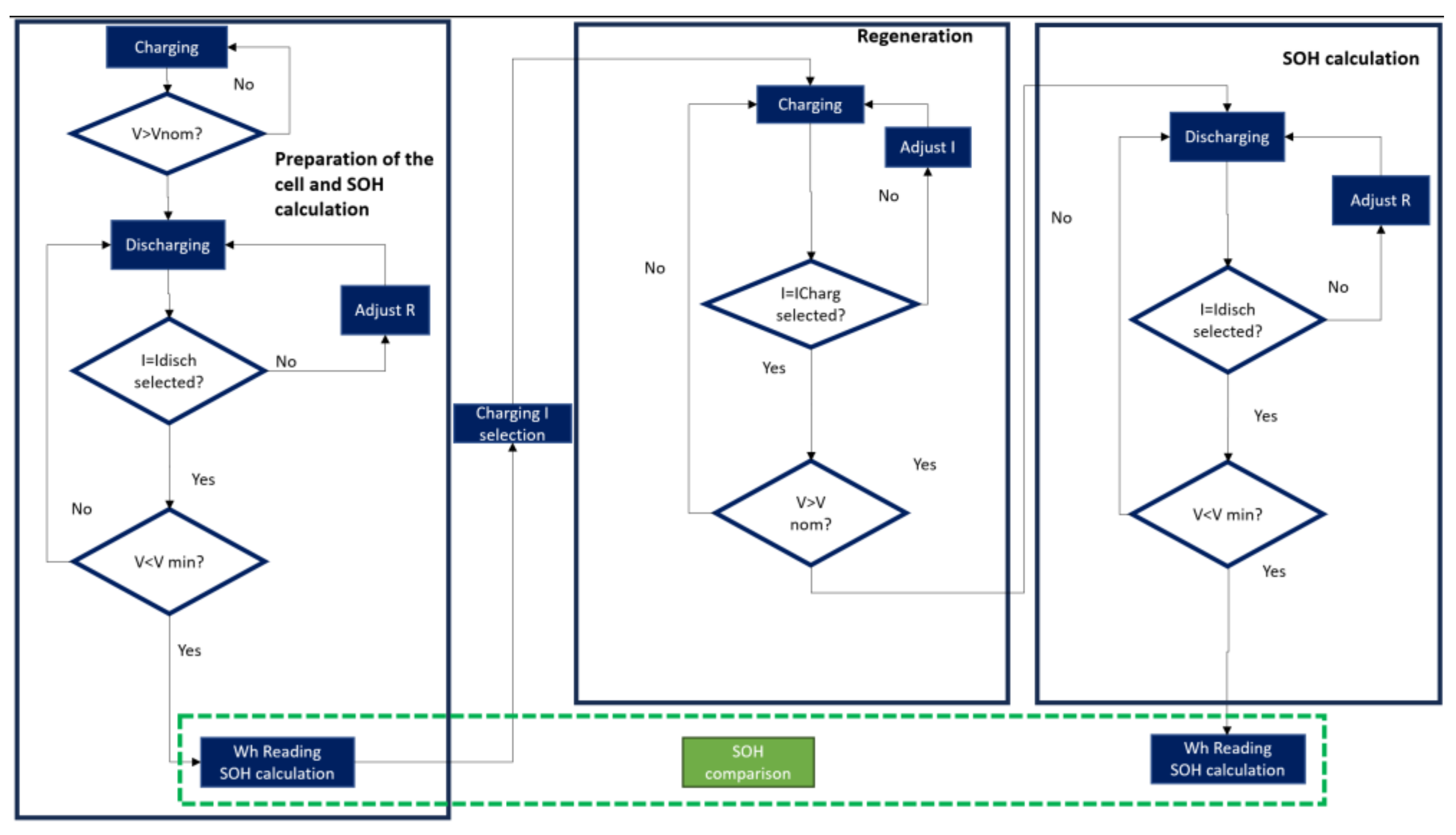
Figure 2.
General operation of the prototype.
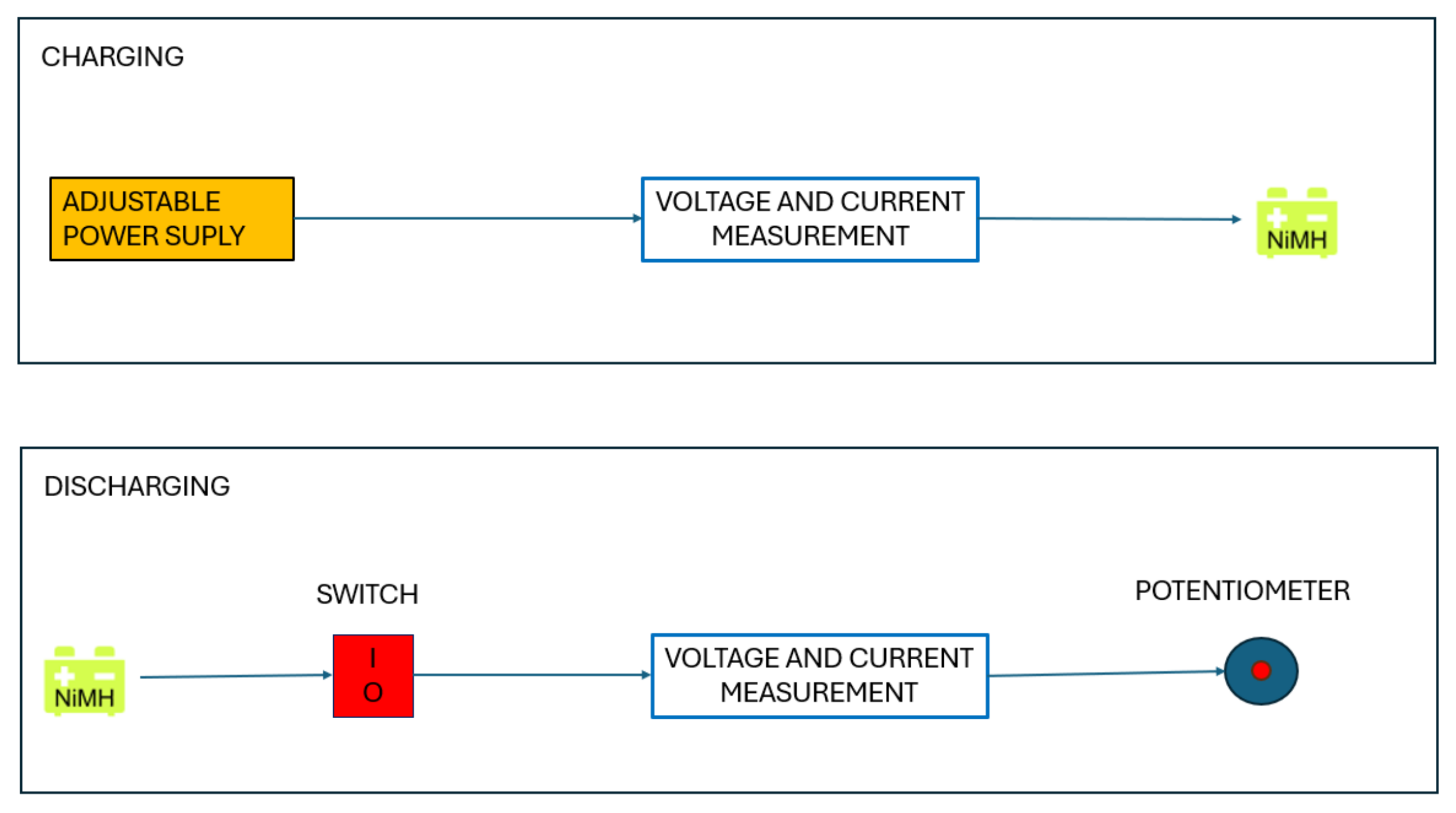
Figure 3.
Electrical diagram of the prototype in charging mode.
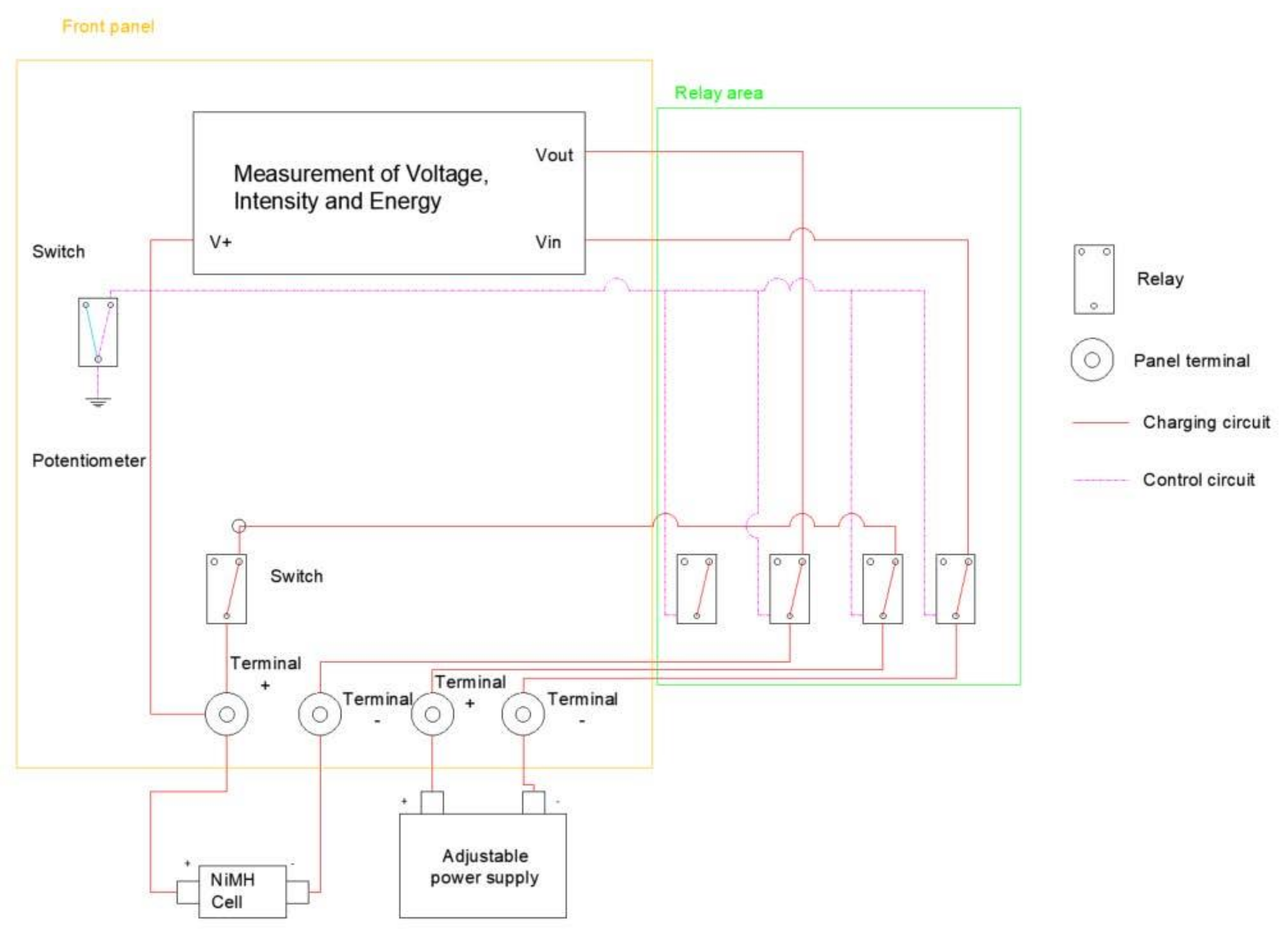
Figure 4.
Electrical diagram of the prototype in discharging mode.
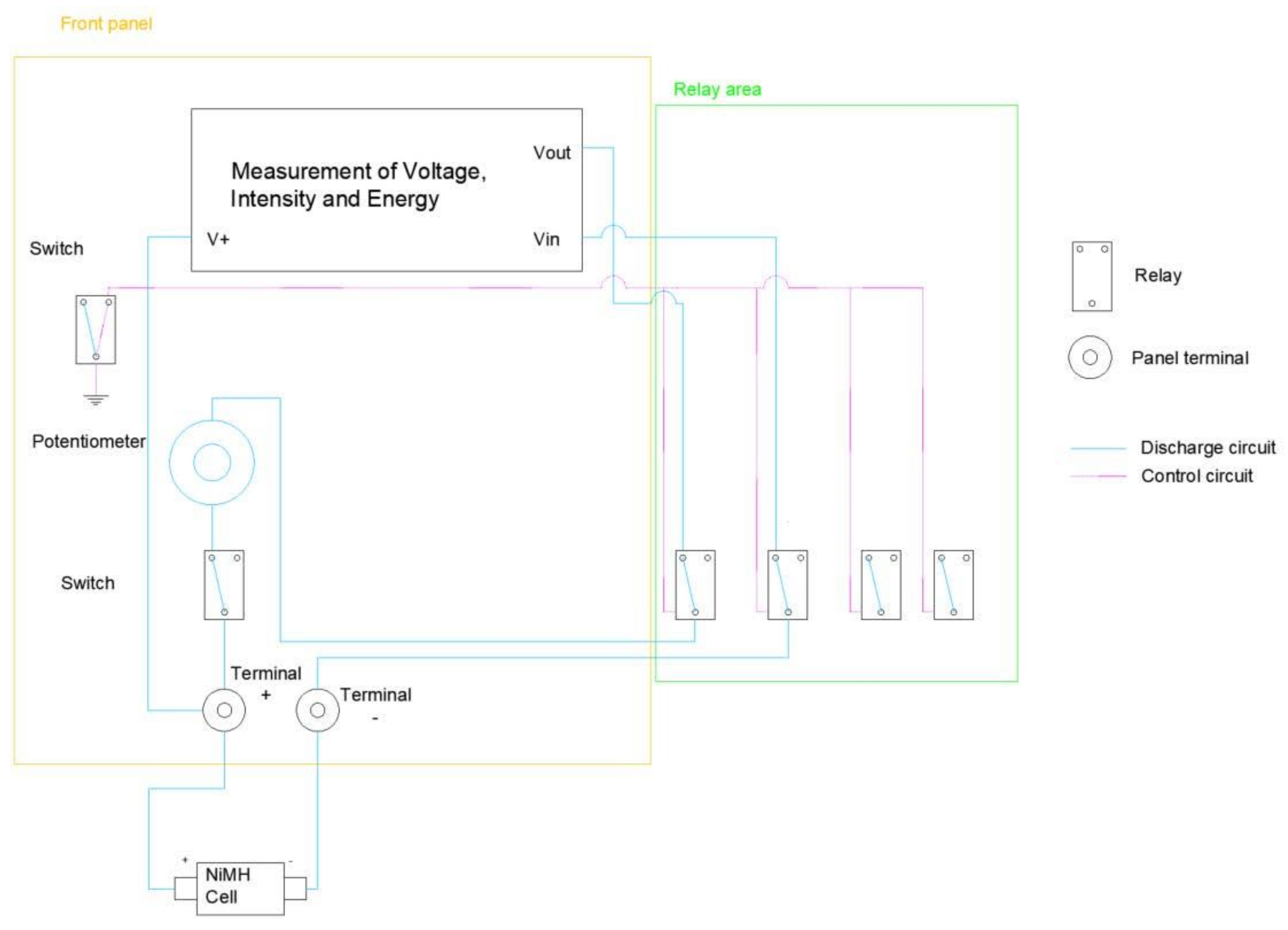
Figure 5.
Power supplies for the cells and additional power supply for the process.
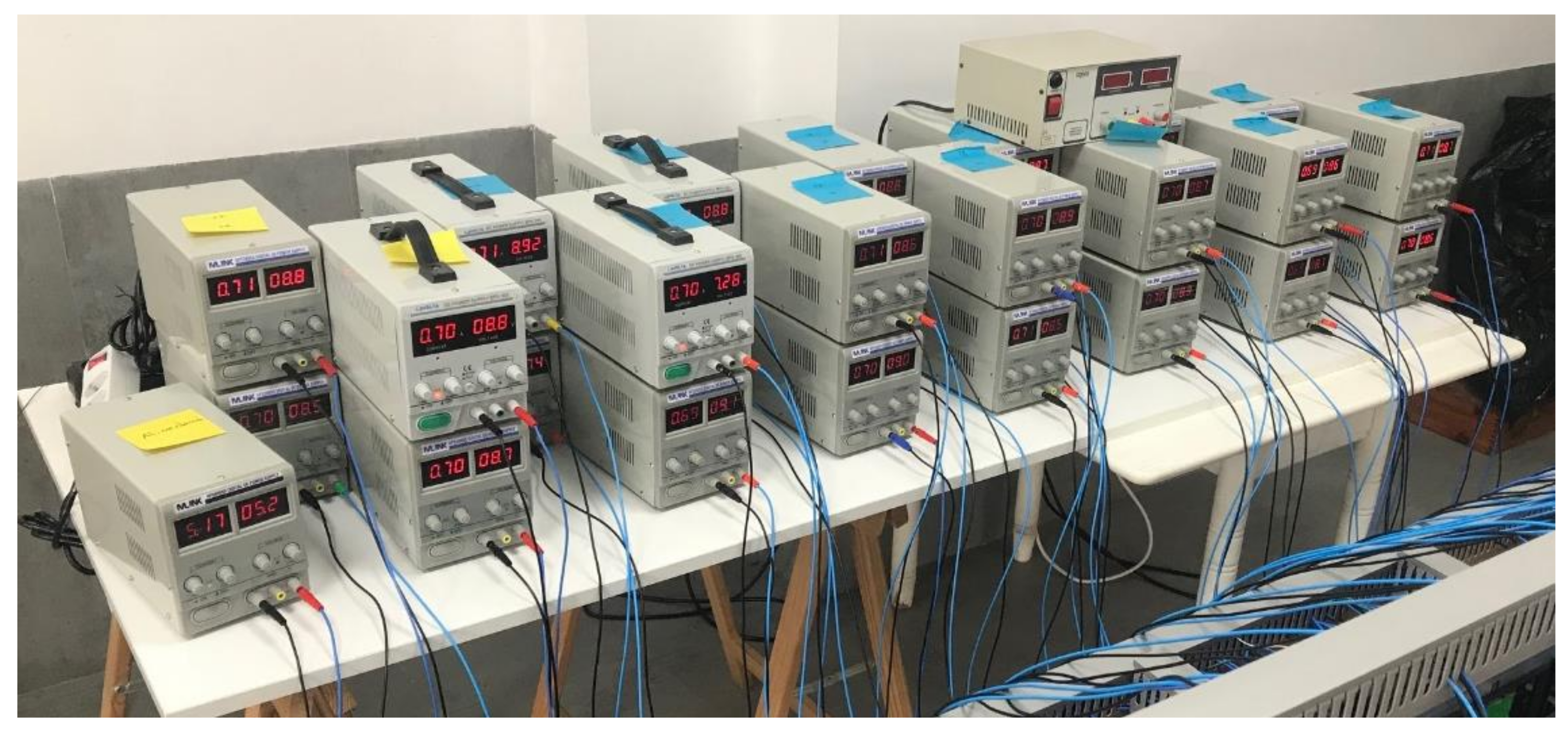
Figure 6.
Potentiometer.
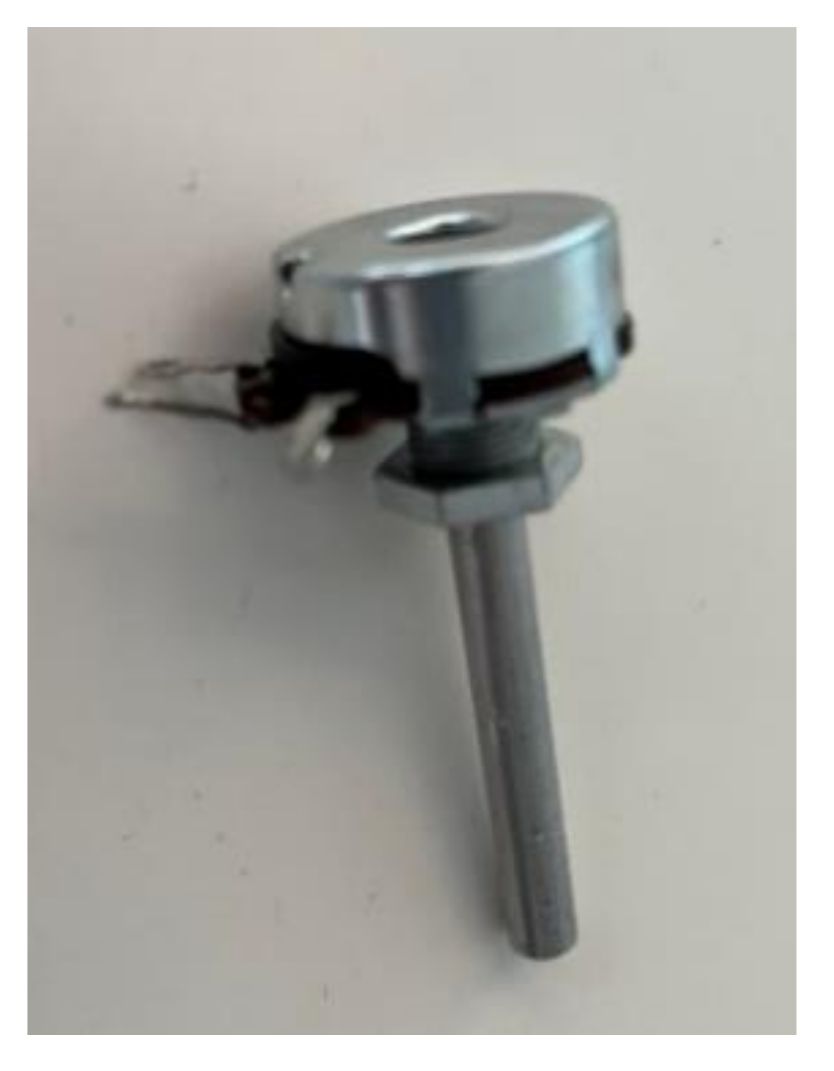
Figure 7.
Display monitoring system.
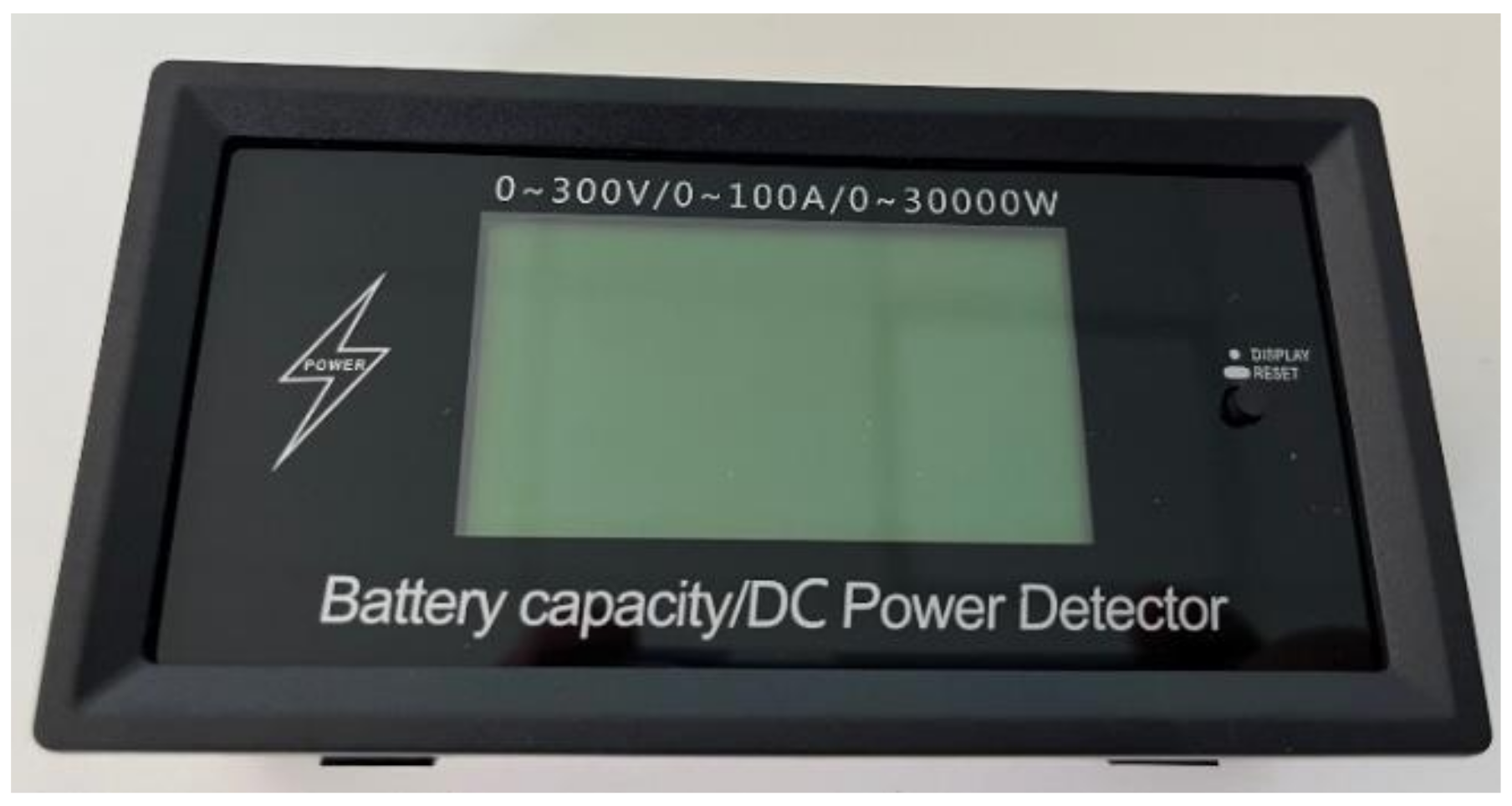
Figure 8.
Example of relays selected.
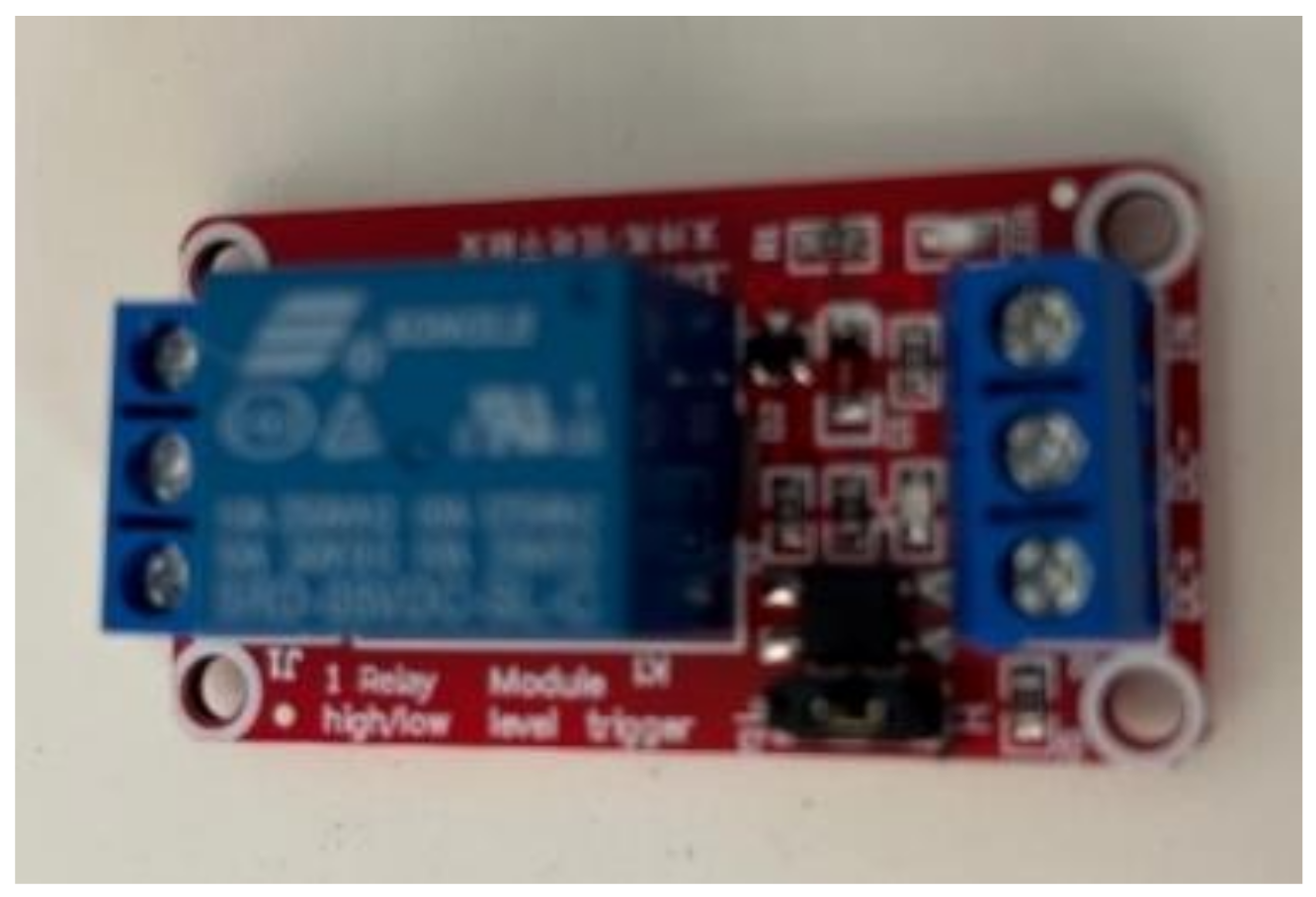
Figure 9.
Example of switch selected.
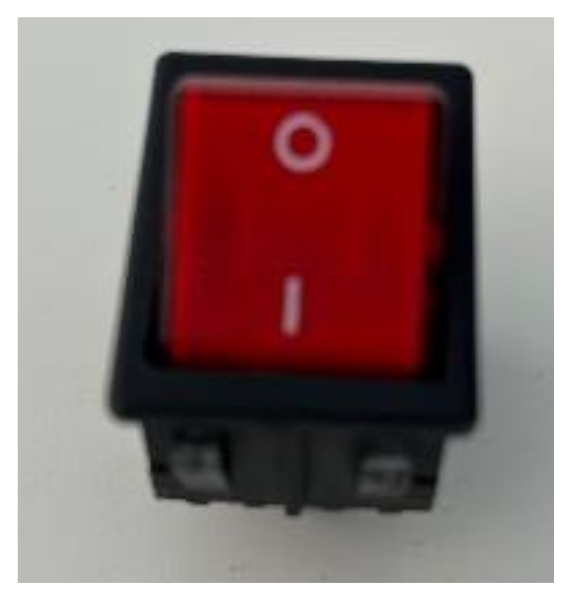
Figure 10.
Frontal panel. General overview.
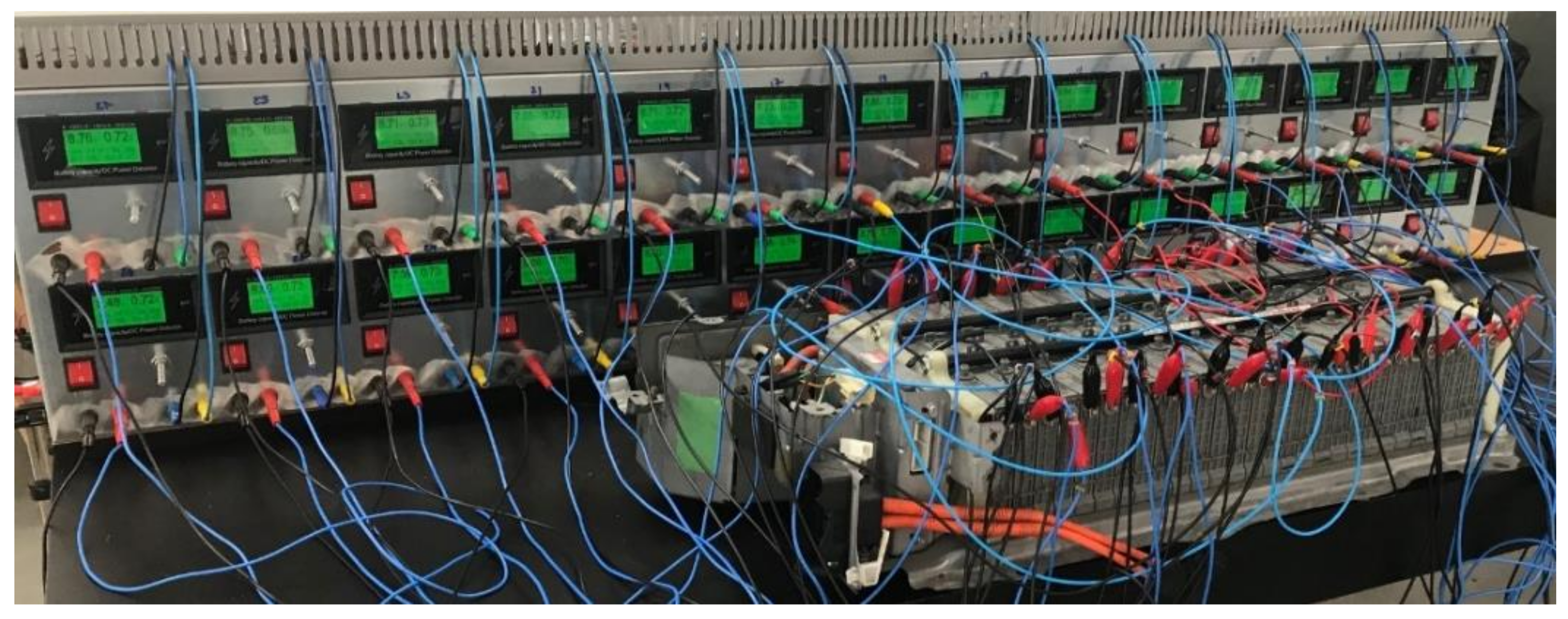
Figure 11.
Rear panel with relays. Example.
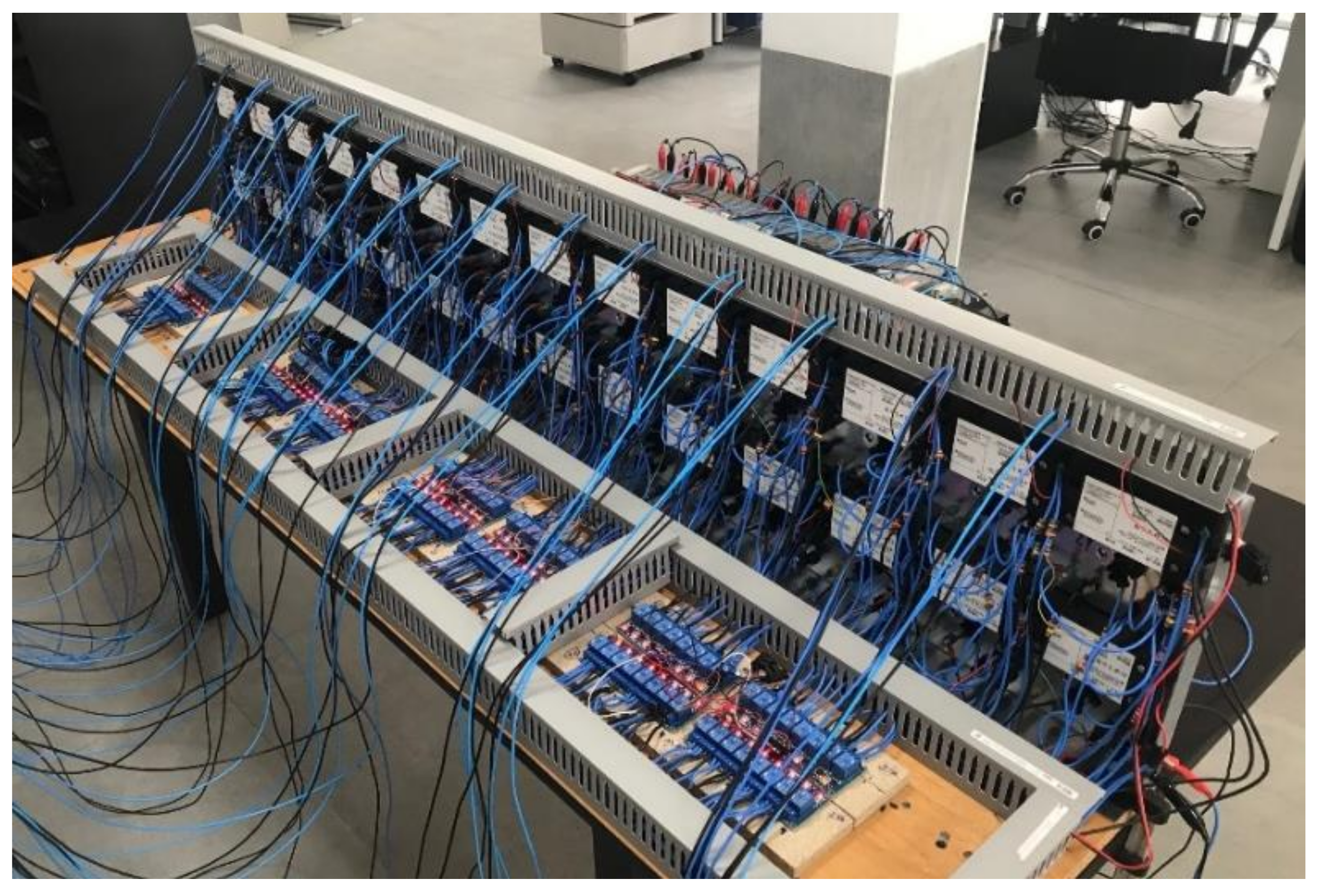
Figure 12.
Energy discharged on cell 3 after each regeneration process.

Figure 13.
Energy discharged on cell in every cello n each process.
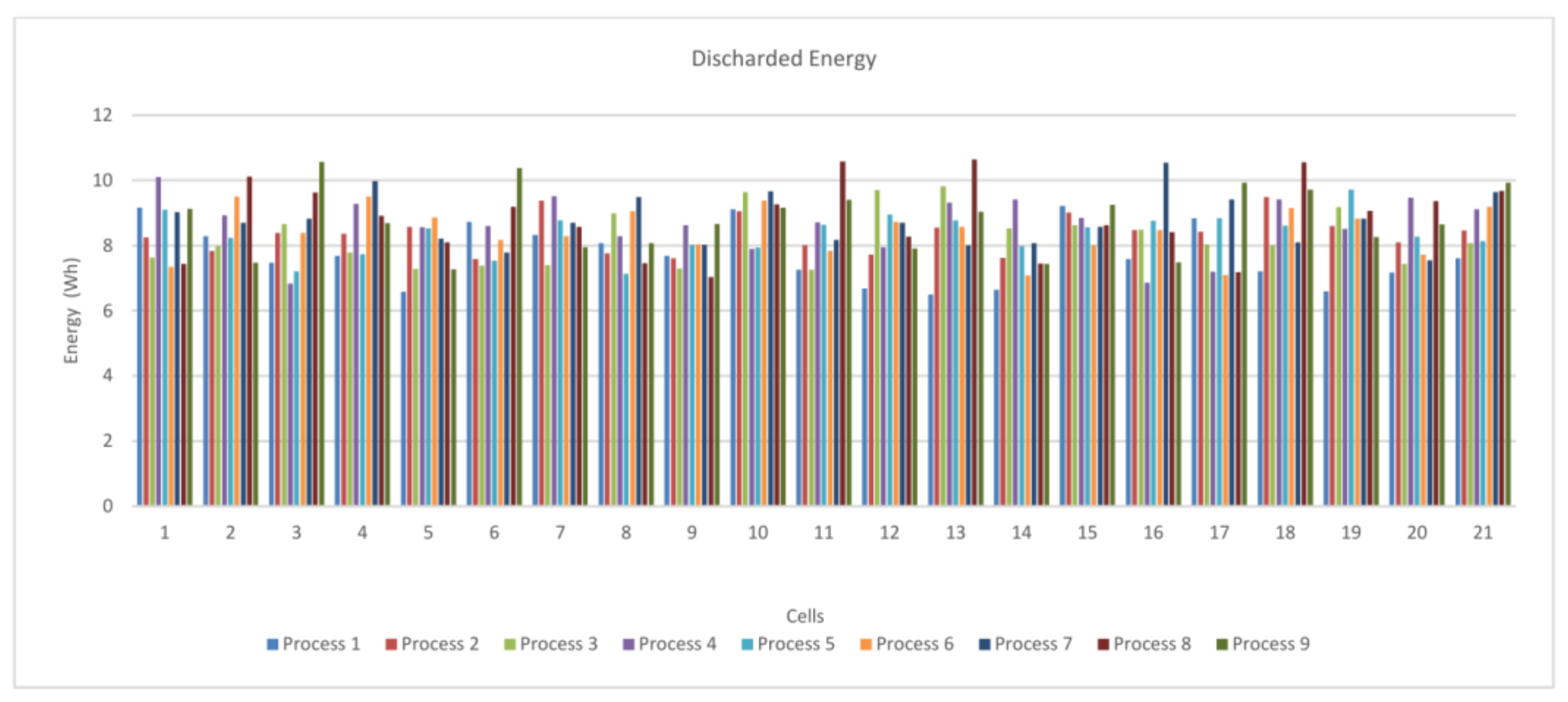
Figure 14.
Relation between energy discharged and energy charged in every cell on each process.
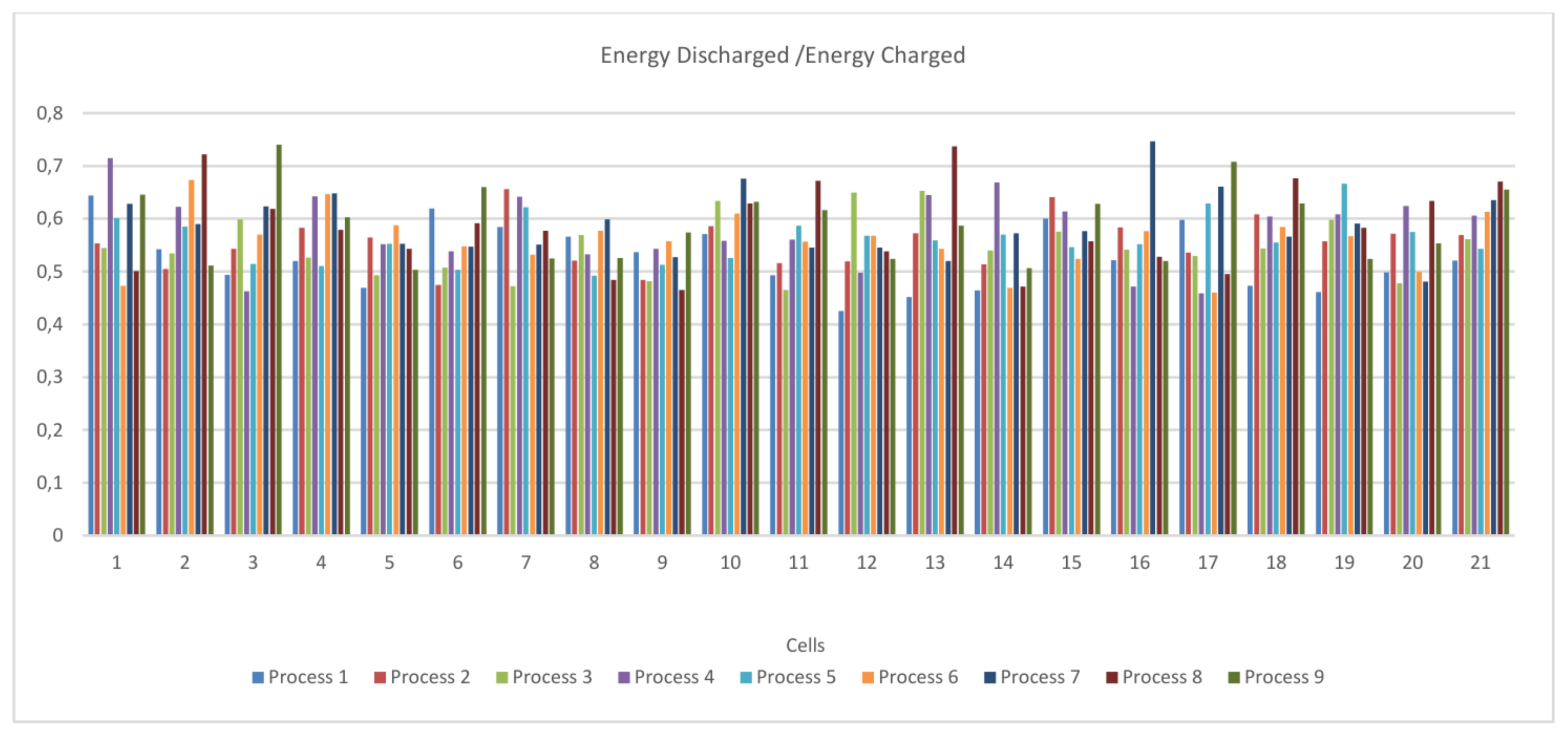
Figure 15.
SOH in every cell on each process.
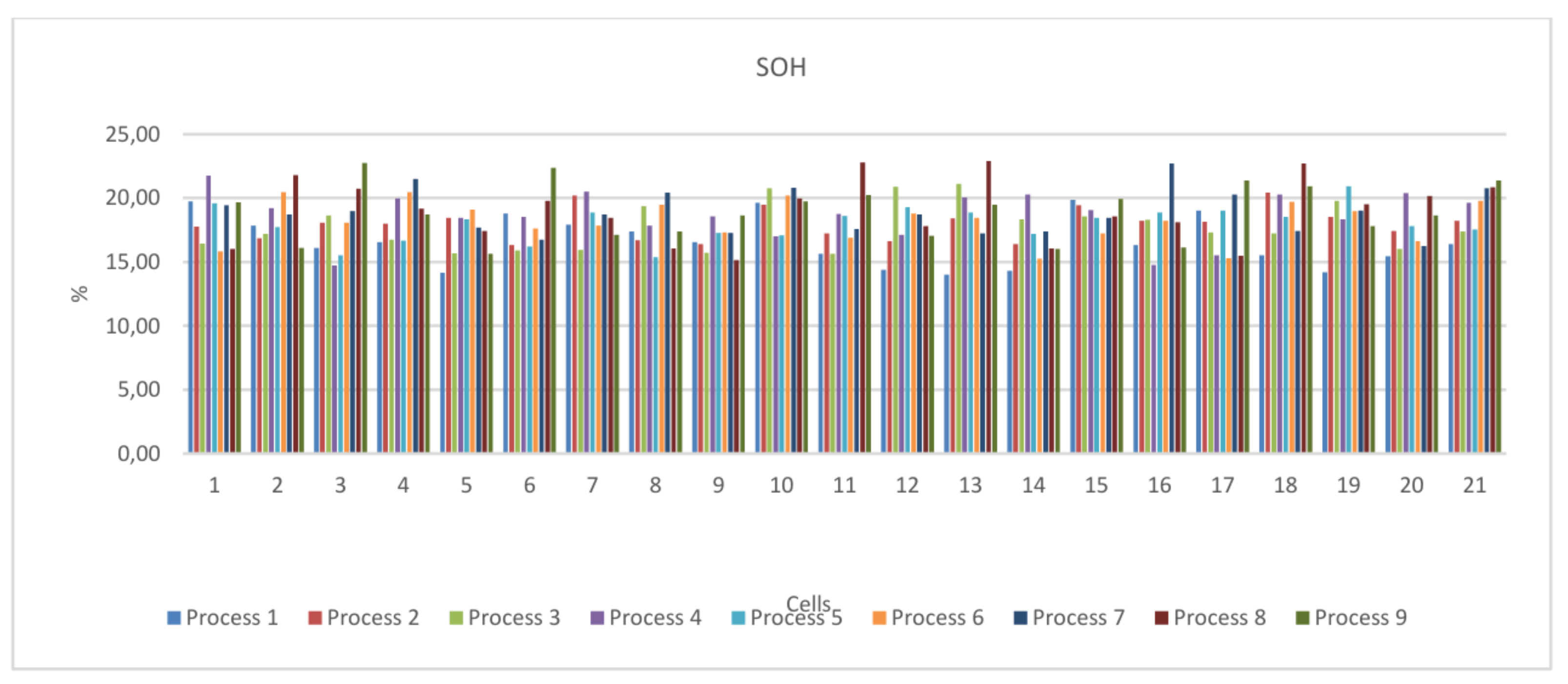
Figure 16.
SOH in cell 21 on each process.
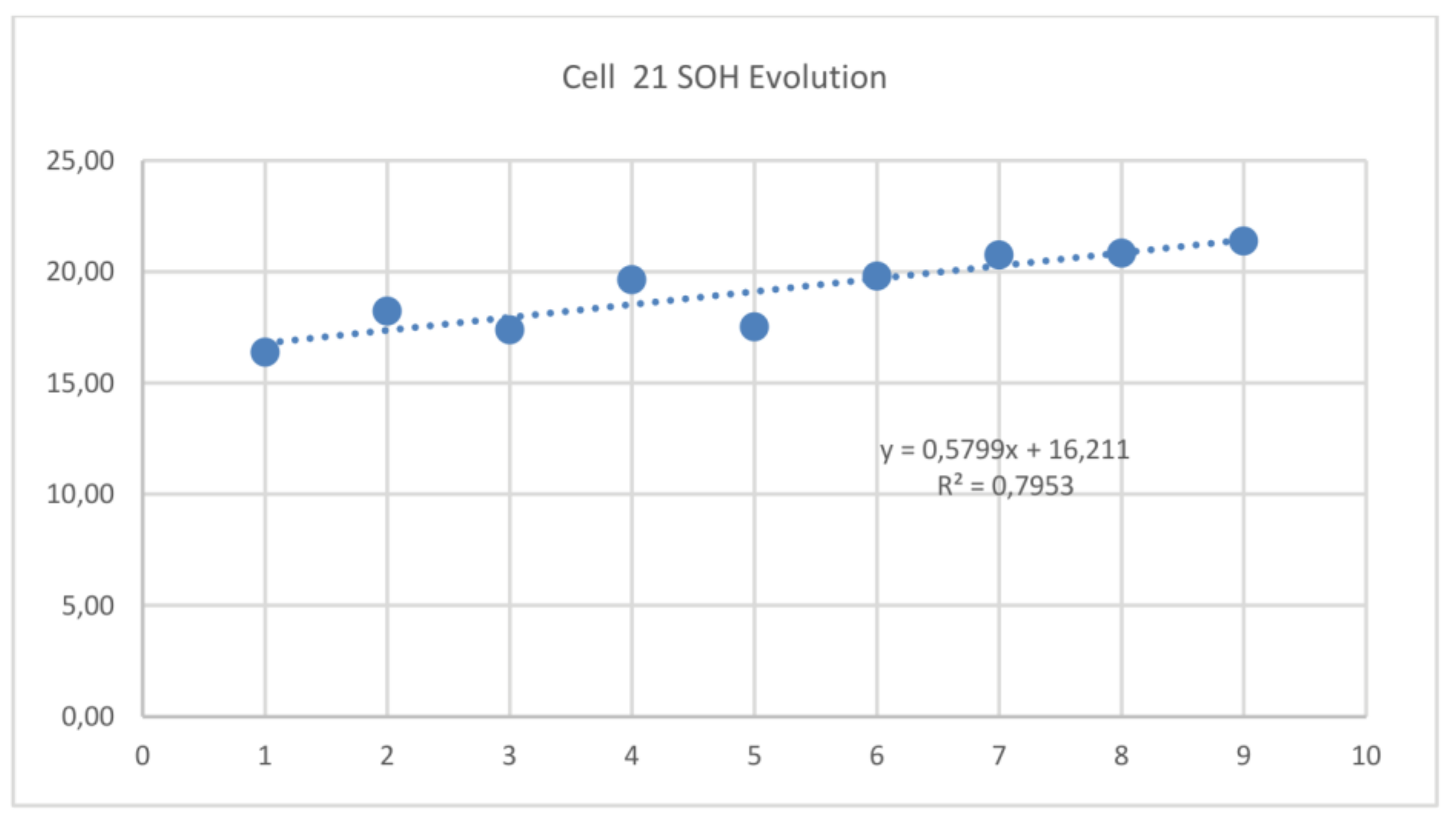
Figure 17.
SOH in cell 11 on each process.
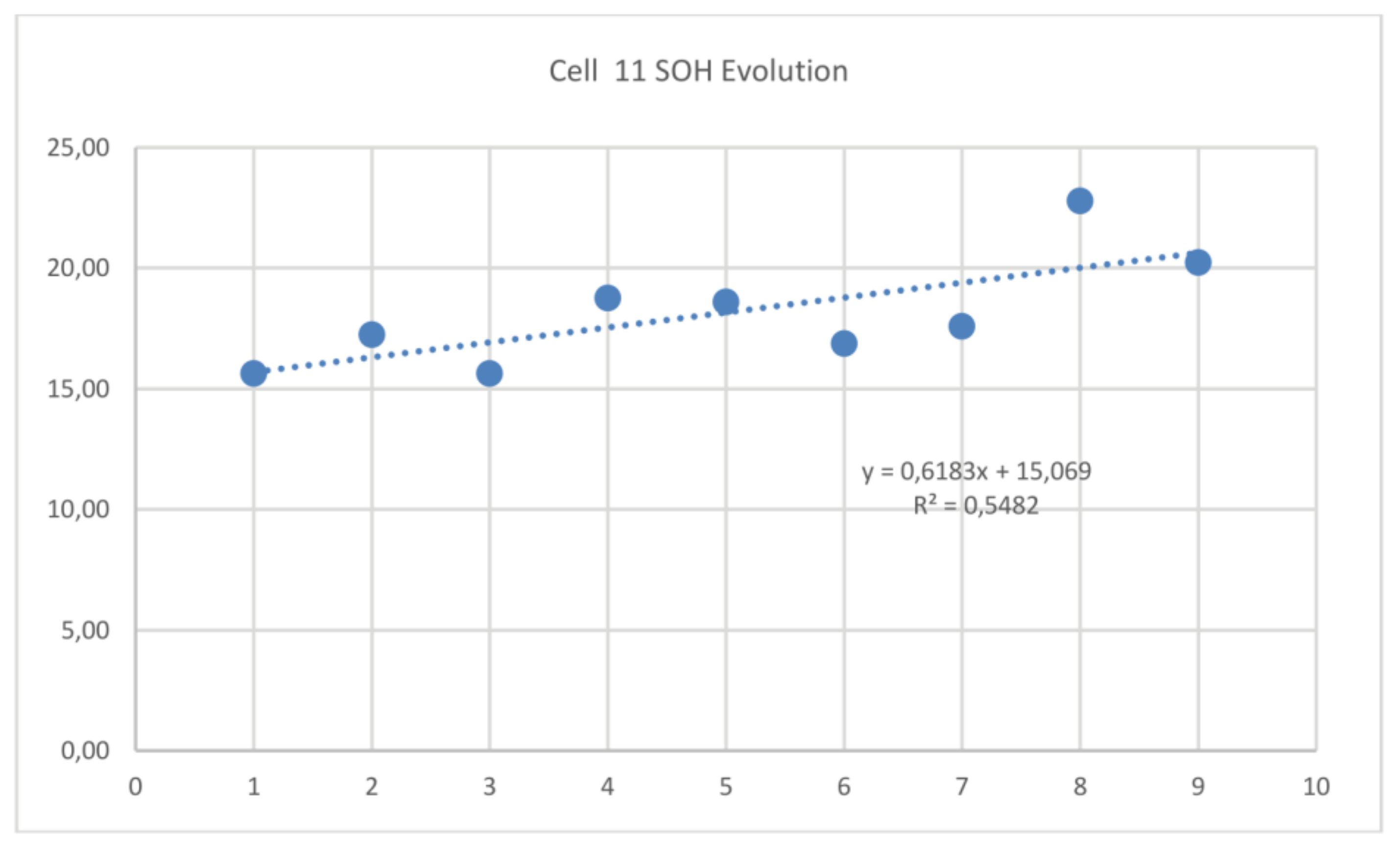
Figure 18.
SOH in cell 3 on each process.
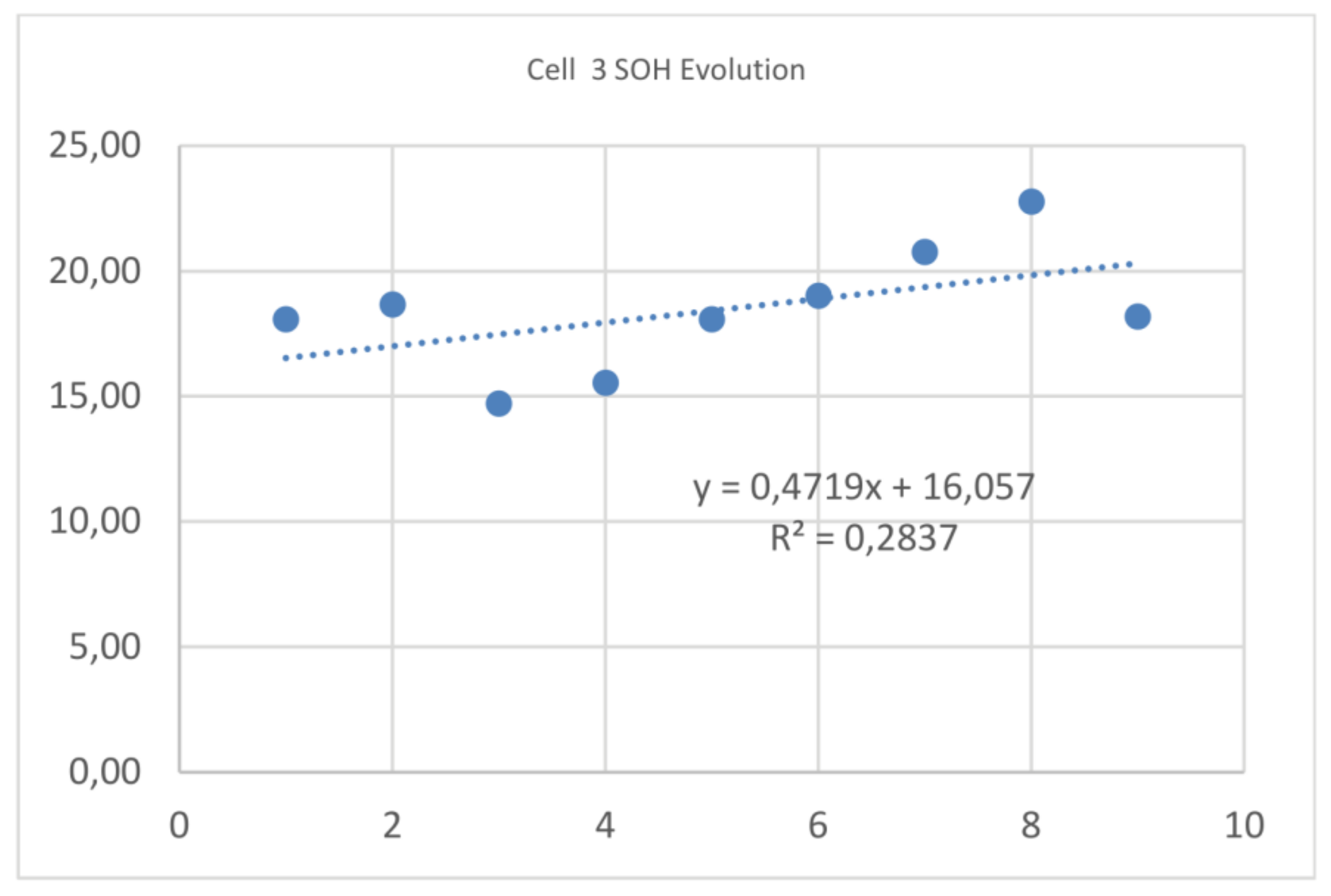
Table 1.
Contributions of NIMH regeneration.
| Year of publication | Published by | Method | Destructive testing | Reference |
|---|---|---|---|---|
| 2004 | Paper | Current Pulses | No | [28] |
| 2005 | Paper | Ultrasound | No | [29] |
| 2014 | Patent | Current Pulses | No | [30] |
| 2021 | Patent | O2 adding | Yes | [31] |
Table 2.
Contributions of NIMH regeneration.
| Charging values | Range |
|---|---|
| Voltage range | 0 ― 30 V |
| Current range | 0 ― 5 A |
| Discharging values | |
| Temperature range | -10 ― +60ºC |
| Voltage range | 0 ― 8.5 V |
| Current range | 0 ― 1 A |
| Operating and control values | |
| Capacity measurement range | 0 ― 99999.9 Wh |
| Sample time | 1 s |
| Minimum voltage power supply | 7.5 V |
| Trigger (value for mode change | 0 V |
Disclaimer/Publisher’s Note: The statements, opinions and data contained in all publications are solely those of the individual author(s) and contributor(s) and not of MDPI and/or the editor(s). MDPI and/or the editor(s) disclaim responsibility for any injury to people or property resulting from any ideas, methods, instructions or products referred to in the content. |
© 2024 by the authors. Licensee MDPI, Basel, Switzerland. This article is an open access article distributed under the terms and conditions of the Creative Commons Attribution (CC BY) license (http://creativecommons.org/licenses/by/4.0/).
Copyright: This open access article is published under a Creative Commons CC BY 4.0 license, which permit the free download, distribution, and reuse, provided that the author and preprint are cited in any reuse.
MDPI Initiatives
Important Links
© 2024 MDPI (Basel, Switzerland) unless otherwise stated







